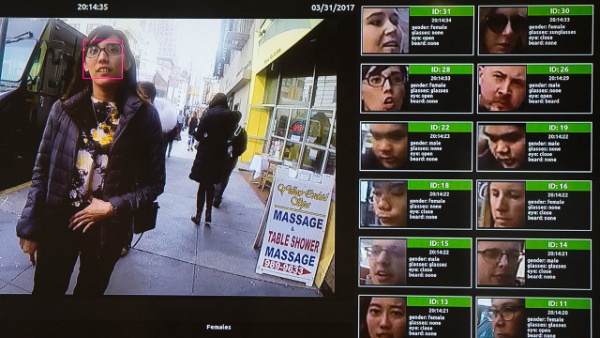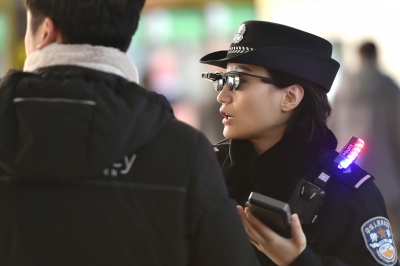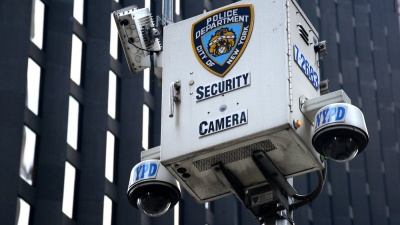Face recognition in law enforcement
Face recognition in law enforcement is a method of cataloging and identifying human faces in order to track people suspected of illegal activity and make arrests. Police often collect mugshots or driver’s license photos to build local, state, and federal face recognition databases. Law enforcement can query these databases to identify people from mugshots, CCTV, or traffic cameras.[1] The software used to return matching database results analyzes patterns based on a person’s facial features and geometry.[2][3] The facial recognition and biometrics market for federal, state, and local law enforcement was a $136.9 million dollar industry in 2018, and is expected to increase to $375 million by 2025.[4] These technologies are particularly controversial for both their likelihood of misidentifying individuals and the potential for the technology to create a surveillance state. The use of face recognition technology for law enforcement has been banned in the American cities San Francisco, Oakland, Berkeley, and Somerville, and there are proposed bans in many other parts of the world.[5]
Contents
Application
China
China is considered to be the world leader in face recognition technology. As of 2018, 170 million CCTV cameras are already in place, and an estimated 400 million are planned to be built by 2021. The government has also expanded their program to include a facial recognition sunglasses program for police on the outskirts of Beijing.[6] China’s use of this technology has been especially criticized for its role in the surveillance and detainment of ethnic minorities, specifically the Muslim Uighur minority in Xinjiang.[7]
Germany
In January 2020, Germany’s Interior Minister announced plans to implement facial recognition systems at 134 railway stations and 14 airports. The plan has not yet been officially confirmed, and has been the subject of criticism by activists groups like the “Face Recognition Stop” alliance over the risk of misidentifications.[8]
India
India currently has plans to create one of the world’s largest facial recognition systems, aiming to build a single, centralized database that could be accessed across all 29 states and seven union territories. The system would match faces from India’s network of CCTV cameras against an image database consisting of mugshots, passport photos, government-issued identity cards, driving licenses, and images from other agencies. The facial recognition system currently used by the government in New Delhi was initially acquired to identify missing children.[9] In March 2020, law enforcement agencies in India used facial recognition to identify more than 1,100 people who took part in the New Delhi riots that occured on February 25 and 26 of 2020.[10]
United States
Face recognition technology is being pursued by multiple local, state, and federal law enforcement agencies in the United States. The first system to take place in the United States began as a project in Pinellas County, Florida in 2001. As of 2016, it is estimated that at least one in four American police agencies could run facial recognition searches.[4] The FBI hosts a Next Generation Identification database with more than 30 million civil and criminal mugshot photos, which can be accessed by many state and local agencies. The FBI also has access to the State Department’s Visa and Passport databases, the Defense Department’s biometric database, and the driver's license databases of at least 16 states, totaling about 412 million images.[11] On a local level, the city of Detroit signed a $1 million dollar deal in 2017 for software that will continuously monitor "hundreds of private and public cameras set up around the city." In September 2019, new provisions were added to ensure the police department could not use facial recognition software on live or recorded video or be used to assess a person's immigration status.[12][13] In San Diego, the TACIDS (Tactical Identification System) program allows law enforcement officers to stop people on the street and use their phones or tablets to take photographs of them and run the images against the county’s mugshot database.[14]
Bans
The use of face recognition technology for law enforcement has been banned in San Francisco, Oakland, Berkeley, and Somerville.[5] Oregon and New Hampshire have banned facel recognition on police body cameras, and Maine and Vermont prohibit the use of face recognition with police drones. Maine, Missouri, New Hampshire, Vermont, Washington, Oregon, and Hawaii all have restrictions on law enforcement’s ability to use driver’s license databases for facial recognition systems.[15]
Ethical Issues
Inaccuracies
A major concern for use of face recognition technology is that it is prone to error, which can implicate people for crimes they have not committed.[16] The FBI wrote in its privacy impact assessment that its system “may not be sufficiently reliable to accurately locate other photos of the same identity, resulting in an increased percentage of misidentifications.” Even when certain systems can accurately identify faces that exist in the database, if a subject is not yet in the database it is likely a system will produce false positive matches.[17]
Racial Bias
Multiple studies have shown that many facial recognition systems have a much higher rate of error for people of color, especially women of color. In 2017, two MIT researchers, Joy Buolamwini and Timnit Gebru, published a study that found that systems developed by Microsoft, IBM, and the Chinese firm Megvii had an error rate for gender recognition for women of color ranging from 23.8% to 36%, whereas lighter-skinned men had an error rate between 0.0 and 1.6%.[18] Another study found similar problems with Amazon’s face recognition technology Rekognition, which has been used by multiple US agencies. It has also been criticized for being used disproportionately against people of color. In 2016, the ACLU revealed that US police agencies had been monitoring protestors and activists by running social media photos through third-party facial recognition software. The system was used during the protests in Ferguson, Missouri following the death of Michael Brown and the protests in Baltimore following the death of Freddie Gray.[19]
Abuse
Face recognition technology has also been criticized as being a breach of privacy and escalating the possibility of enabling a surveillance state. Some claim that face recognition inherently undermines the freedom of citizens by enabling complete surveillance of everyone, all the time.[20]
In 2018, a controversy in India began when opposition politician Ajay Maken accused the New Delhi government of having awarded a contract to provide about half of the CCTV cameras it plans to install in the capital to Prama Hikvision, a joint venture between Chinese company Hikvision and Indian company Prama Technologies, which would put citizens at risk for espionage. Ashish P. Dhakan, Prama Hikvision's CEO, confirmed that the company was awarded the contract but denied any unauthorized collection of information or espionage.[9] Hikvision, however, has been barred from selling technology to U.S. federal government agencies and been connected to the detainment of roughly a million people without formal charges, mostly from the Muslim Uighur minority in Xinjiang.[7]
References
- ↑ Georgetown Law Center on Privacy & Technology. "The Perpetual Line-up: Unregulated Police Face Recognition in America" Retrieved on 5 March 2020.
- ↑ Steve Symanovich. "How does facial recognition work?" Retrieved on 5 March 2020.
- ↑ Andrew Heinzman. "How Does Facial Recognition Work?" Retrieved on 5 March 2020.
- ↑ 4.0 4.1 Claire Merchlinsky. "How facial recognition became a routine policing tool in America" Retrieved on 5 March 2020.
- ↑ 5.0 5.1 Sean Captain. "Portland plans to propose the strictest facial recognition ban in the country" Retrieved on 5 March 2020.
- ↑ Shannon Liao. "Chinese police are expanding facial recognition sunglasses program" Retrieved on 5 March 2020.
- ↑ 7.0 7.1 Cate Cadell. "Hikvision, a surveillance powerhouse, walks U.S.-China tightrope" Retrieved on 5 March 2020.
- ↑ Philipp Grüll. "Germany’s plans for automatic facial recognition meet fierce criticism" Retrieved on 5 March 2020.
- ↑ 9.0 9.1 Julie Zaugg. "India is trying to build the world's biggest facial recognition system" Retrieved on 5 March 2020.
- ↑ Manish Singh. "https://techcrunch.com/2020/03/11/india-used-facial-recognition-tech-to-identify-1100-individuals-at-a-recent-riot/" Retrieved on 5 March 2020.
- ↑ Jennifer Lynch. "New Report: FBI Can Access Hundreds of Millions of Face Recognition Photos" Retrieved on 5 March 2020.
- ↑ Joe Guillen. "Detroit police oversight board approves controversial facial recognition policy" Retrieved on 5 March 2020.
- ↑ Sasha Ingber. "Major Police Body Camera Manufacturer Rejects Facial Recognition Software" Retrieved on 5 March 2020.
- ↑ Ali Winston. "Facial recognition, once a battlefield tool, lands in San Diego County" Retrieved on 5 March 2020.
- ↑ Jon Schuppe. "Facial recognition gives police a powerful new tracking tool. It's also raising alarms." Retrieved on 5 March 2020.
- ↑ Rand Corportation. "Biometrics Expert Delivers Lecture on Facial Recognition" Retrieved on 5 March 2020.
- ↑ EFF. "Face Recognition" Retrieved on 5 March 2020.
- ↑ [Joy Buolamwini, Timnit Gebru. "Gender Shades: Intersectional Accuracy Disparities in Commercial Gender Classification" Retrieved on 5 March 2020.
- ↑ Terry Collins. "Facial recognition: Do you really control how your face is being used?" Retrieved on 5 March 2020.
- ↑ Alex Hern. "What is facial recognition - and how do police use it?" Retrieved on 5 March 2020.


